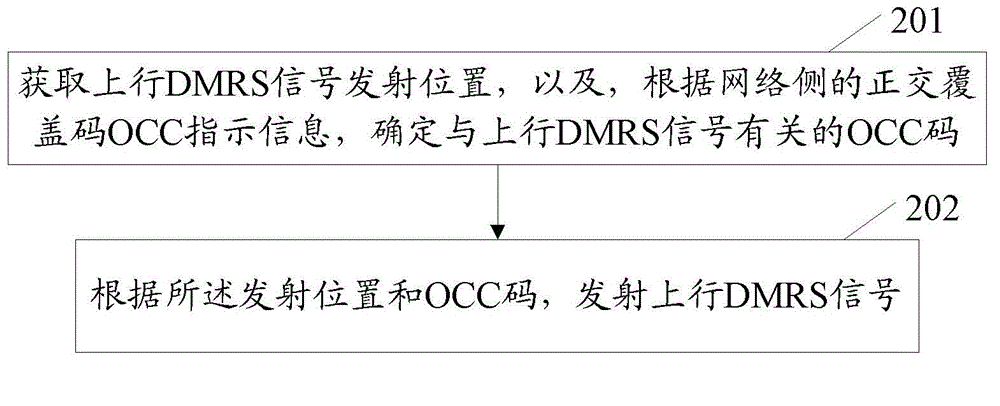Method and system for transmitting uplink demodulation reference signal
A technology for demodulating reference signals and signals, applied in the field of transmitting uplink demodulation reference signals, can solve the problems of high DMRS overhead, high uplink DMRS overhead, low efficiency, etc., and achieve the effect of improving coverage capacity and reducing overhead
- Summary
- Abstract
- Description
- Claims
- Application Information
AI Technical Summary
Problems solved by technology
Method used
Image
Examples
Embodiment 1
[0066] Such as image 3 As shown, it is a schematic diagram of the method for transmitting uplink DMRS in Embodiment 1; wherein, slanted lines indicate the transmitting position of the uplink DMRS, and non-oblique lines indicate the transmitting position of the uplink data.
[0067] Assume normal CP length, and the transmission time windows are subframe 1 and subframe 2.
[0068] Wherein, the transmission time window refers to consecutive subframes allocated by the network side to the user side.
[0069] The transmission position of the uplink DMRS signal can be determined in two ways, including:
[0070] The network side and the user have pre-negotiated the transmission position of the uplink DMRS signal, and each time the user obtains the transmission position, it can be directly determined according to the negotiated result; or,
[0071] The uplink DMRS signal transmission position is determined according to the transmission position indication information on the network ...
Embodiment 2
[0091] Such as Figure 4 As shown, it is a schematic diagram of the method for transmitting uplink DMRS according to the second embodiment; wherein, slanted lines represent uplink DMRS transmission positions, and non-twill lines represent uplink data transmission positions.
[0092] Assume normal CP length, and the transmission time windows are subframe 1, subframe 2 and subframe 3.
[0093] Wherein, the transmission time window refers to consecutive subframes allocated by the network side to the user side.
[0094] The transmission position of the uplink DMRS signal can be determined in two ways, including:
[0095] The network side and the user have pre-negotiated the transmission position of the uplink DMRS signal, and each time the user obtains the transmission position, it can be directly determined according to the negotiated result; or,
[0096] The uplink DMRS signal transmission position is determined according to the transmission position indication information on ...
Embodiment 3
[0116] Such as Figure 5 As shown, it is a schematic diagram of the method for transmitting uplink DMRS according to the third embodiment; wherein, oblique lines indicate the transmitting position of the uplink DMRS, and non-oblique lines indicate the transmitting position of the uplink data.
[0117] Assume normal CP length, and the transmission time windows are subframe 1, subframe 2 and subframe 3.
[0118] Wherein, the transmission time window refers to consecutive subframes allocated by the network side to the user side.
[0119] The transmission position of the uplink DMRS signal can be determined in two ways, including:
[0120] The network side and the user have pre-negotiated the transmission position of the uplink DMRS signal, and each time the user obtains the transmission position, it can be directly determined according to the negotiated result; or,
[0121] The uplink DMRS signal transmission position is determined according to the transmission position indicat...
PUM
 Login to View More
Login to View More Abstract
Description
Claims
Application Information
 Login to View More
Login to View More - R&D Engineer
- R&D Manager
- IP Professional
- Industry Leading Data Capabilities
- Powerful AI technology
- Patent DNA Extraction
Browse by: Latest US Patents, China's latest patents, Technical Efficacy Thesaurus, Application Domain, Technology Topic, Popular Technical Reports.
© 2024 PatSnap. All rights reserved.Legal|Privacy policy|Modern Slavery Act Transparency Statement|Sitemap|About US| Contact US: help@patsnap.com










